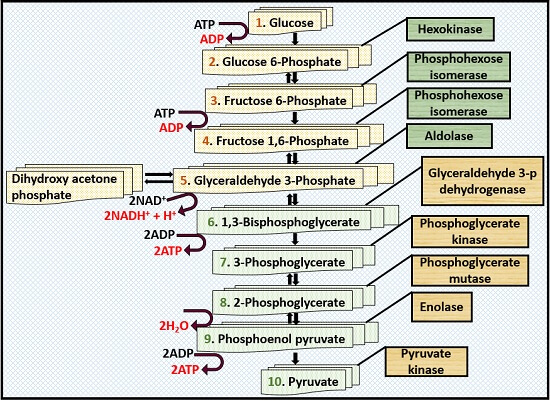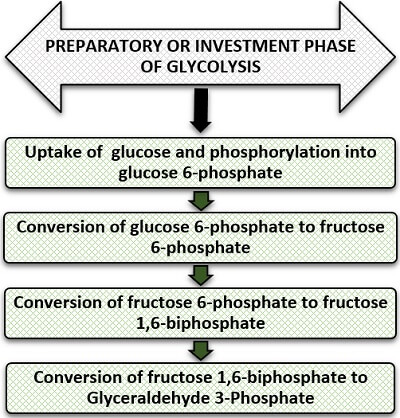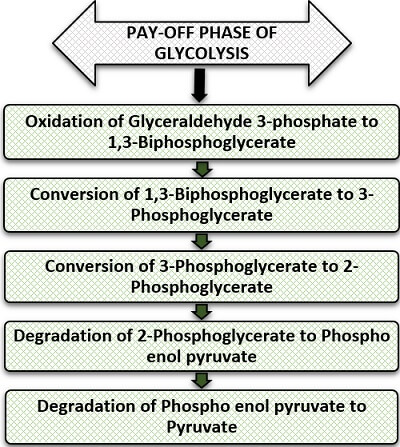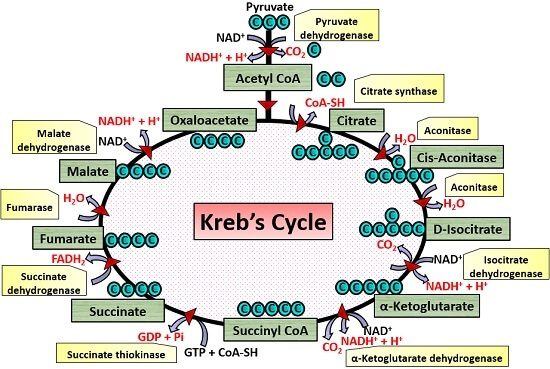The differences between glycolysis and Krebs cycle are mainly due to the following factors like:
- The occurrence of the process
- Type of respiration
- Net energy production, i.e. ATP
The occurrence of the Process: Glycolysis occurs in the cytoplasm, whereas the Krebs cycle occurs inside the mitochondria.
Type of Respiration: Glycolysis can carry out both aerobic and anaerobic kind of respiration, whereas the Krebs cycle only carries out aerobic respiration.
Net energy production: The net production of ATP in glycolysis is 8 molecules, while in Kreb’s cycle the net production is 12 molecules.
In this context, we will study the key differences between the glycolysis and the Krebs cycle, along with the comparison chart. Besides, we will also get to know the whole process and the net energy production of both the metabolic pathways.
Content: Glycolysis Vs Krebs Cycle
Comparison Chart
| Properties | Glycolysis | Kreb’s cycle |
|---|---|---|
| Alternative name | EMP pathway (Embden, Meyerhof & Parnas pathway) | TCA cycle (Tri-Carboxylic Acid cycle) |
| Substrate | Glucose | Pyruvate |
| End product | Pyruvate | Oxaloacetate |
| Occurrence | Cytoplasm | Mitochondria |
| Respiration stage | First stage of cellular respiration | Second stage of cellular respiration |
| Flow of pathway | Linear | Cyclic |
| Oxidative phosphorylation | Do not involved in oxidative phosphorylation | Involved in oxidative phosphorylation |
| Respiration type | Cytoplasmic respiration | Mitochondrial respiration |
| ATP input | Consumes 2molecules of ATP | Do not consumes ATP |
| ATP output | Produces 8molecules of ATP | Produces 24molecules of ATP |
| Number of enzymes needed | Ten | Eight |
| Oxygen requirement | Can occur in both presence and absence of oxygen | Occurs in presence of oxygen |
| CO2 evolvement | Absent | Present |
Definition of Glycolysis
It can be defined as the lysis or degradation of a simple carbohydrate, i.e. Glucose into a chemical compound Pyruvate (the anion of the pyruvic acid). It was discovered by Embden, Meyerhof and Parnas for which the glycolysis pathway also termed as EMP pathway. The glycolysis process occurs in a cell cytosol, i.e. the extramitochondrial soluble fraction. It is the linear pathway, which involves sequential chemical modification, each by different enzymes.
Definition of Krebs Cycle
It can be defined as the oxidation of key intermediate, i.e. Pyruvate that is formed by the glycolysis process into an end product Oxaloacetate. It was discovered by Szent Gyorgyi and Hans Krebs for which this cycle is also termed as Szent-Gyorgyi- Krebs cycle. The Krebs cycle occurs inside the mitochondria. It is the cyclic pathway, where the cycle continues in the same pattern.
Process of Glycolysis
It has a preparatory phase and pay-off phase.

Preparatory Phase
It is also called as the investment phase. It involves the conversion or phosphorylation of glucose into glyceraldehyde 3-phosphate. During this phase, ATP is consumed by the cell. Thus, the preparatory phase involves the following steps:

- Uptake of glucose by the cells and its phosphorylation: The glucose is uptaken by the cell and phosphorylated into glucose 6-phosphate. This reaction consumes one molecule of an ATP. An enzyme hexokinase catalyzes the reaction.
- Conversion of glucose 6-phosphate: In this, conversion of glucose 6-phosphate to fructose 6-phosphate occurs by an enzyme phosphohexose isomerase.
- Conversion of fructose 6-phosphate: In this, conversion of fructose 6-phosphate to fructose 1, 6-biphosphate occurs by an enzyme phosphofructokinase-1. This reaction consumes another molecule of an ATP.
- The transition of fructose 1, 6-biphosphate: In this, splitting of fructose 1, 6-phosphate occurs, which forms two molecules of triose phosphates. One is glyceraldehyde 3-phosphate (Aldotriose), and other is dihydroxyacetone phosphate (Ketotriose). Aldolase catalyzes this reaction. The reaction of glyceraldehyde 3-phosphate and dihydroxyacetone phosphate is the reversible reaction and catalyzed by an enzyme triosephosphate isomerase.
Pay-off phase
It involves the conversion or oxidation of glyceraldehyde 3-phosphate to pyruvate. During this phase, ATP is released by the cell. Thus, the pay off phase involves the following steps:

- Oxidation of Glyceraldehyde 3-phosphate: In this reaction, glyceraldehyde 3-phosphate oxidizes into 1, 3-biphosphoglycerate. Here, two molecules of NADH+ releases. Glyceraldehyde 3-phosphate dehydrogenase catalyzes this reaction.
- Conversion of 1, 3-Biphosphoglycerate: In this reaction, 1, 3-biphosphoglycerate converts into 3-phosphoglycerate by forming two molecules of an ATP through an enzyme phosphoglycerate kinase.
- The transition of 3-Phosphoglycerate: In this reaction, 3-biphosphoglycerate converts into 2-phosphoglycerate by an enzyme phosphoglycerate mutase.
- Degradation of 2-Phosphoglycerate: In this reaction, 2-phosphoglycerate converts into phosphoenolpyruvate by enzyme enolase along with the release of two H2O molecules.
- Degradation of Phosphoenolpyruvate: In this reaction, phosphoenolpyruvate converts into pyruvate by an enzyme pyruvate kinase along with the release of two ATP molecules.
Process of Krebs Cycle
In the Krebs cycle, the process is in cyclic form, and it does not involve preparatory and pay off phase, unlike glycolysis. It involves oxidation of pyruvate (a key intermediate of glycolysis) to acetyl CoA, which initiates the Kreb’s cycle. The steps of Kreb’s cycle includes the following steps:

- Condensation of Acetyl CoA: In this, Acetyl CoA forms by the end product of the glycolytic pathway that is Pyruvate by releasing one molecule of NADH+. Acetyl CoA further oxidizes to form citrate by releasing CoA-SH.
- Isomerization of citrate: In this, Citrate isomerizes into D-Isocitrate, during which an intermediate product forms that are Cis- Aconitase where both the reaction catalyzes by the enzyme “Aconitase”. This reaction produces two molecules of H2O.
- Oxidative decarboxylation of Isocitrate: In this reaction, Isocitrate converts into α-Ketoglutarate, catalyzes by an enzyme “Isocitrate dehydrogenase” by releasing one molecule of CO2 and another molecule of NADH+.
- Oxidative decarboxylation of α-Ketoglutarate: In this, α-Ketoglutarate converts into Succinyl CoA. Here one molecule of CO2 and another molecule of NADH+ releases. This reaction catalyzes by an enzyme “α-Ketoglutarate dehydrogenase”.
- Conversion of Succinyl CoA: During this reaction, Succinyl CoA converts into Succinate catalyzes by an enzyme “Succinate thiokinase” by releasing one molecule of GDP.
- Oxidation of Succinate: In this Succinate converts into Fumarate catalyzes by an enzyme “Succinate dehydrogenase” by releasing one molecule of FADH2.
- Hydration of Fumarate: In this Fumarate converts into Malate catalyzes by an enzyme “Fumarase” by releasing one molecule of H2O.
- Oxidation of malate: In this Malate converts into Malate catalyzes by an enzyme “Malate dehydrogenase” by releasing one molecule of NADH+.
Net Production of ATP in Glycolysis
The net production of the glycolytic pathway is two molecules each of ADP, NADH+, H2O and four molecules of ATP. Therefore, from two molecules of NADH+, we will get six molecules of ATP plus four molecules of ATP in the direct substrate-level phosphorylation gives 10 molecules of ATP. But, as the two ATP molecule are consumed in the preparatory phase, there will be a total of 8 ATP molecules.
| Step | Phase | Enzyme | ATP invested | ATP released | Net production |
|---|---|---|---|---|---|
| 1 | Preparatory phase | Hexokinase | 1ATP | -1 | |
| 3 | Phosphofructokinase | 1ATP | -1 | ||
| 6 | Pay-off phase | Glyceraldehyde 3-P dehydrogenase | 6ATP (by two molecules of NADH+) | +6 | |
| 7 | Phosphoglycerate kinase | 2ATP | +2 | ||
| 10 | Pyruvate kinase | 2ATP | +2 | ||
| Total | 10-2= 8 ATP molecules per glycolysis pathway | ||||
Net Production of ATP in the Krebs Cycle
The net production of the glycolytic pathway is three molecules each of NADH+, H2O and one molecule of GDP and QH2. Therefore, three molecules of NADH+ will form nine molecules of ATP. One molecule of GDP gives one molecule of ATP. One molecule of FADH2 gives two molecules of ATP i.e. a total of 12 ATP molecules per TCA-cycle.
| Step | Enzyme | Source of ATP | Net production |
|---|---|---|---|
| 3 | Isocitrate dehydrogenase | 1 NADH+ | 3 ATP |
| 4 | α-Ketoglutarate dehydrogenase | 1 NADH+ | 3 ATP |
| 5 | Succinate thiokinase | 1 GDP | 1 ATP |
| 6 | Succinate dehydrogenase | 1 FADH2 | 2 ATP |
| 8 | Malate dehydrogenase | 1 NADH+ | 3 ATP |
| Total | 12 ATP molecules per TCA cycle |
Key Differences Between Glycolysis and Krebs Cycle
- The alternative names for glycolysis and Krebs cycle are the EMP pathway (which was named after the scientists Embden, Meyerhof & Parnas pathway) and TCA cycle (Tri-Carboxylic Acid cycle), respectively.
- Glycolysis starts with the substrate glucose that forms an end product, i.e. pyruvate. In the Krebs cycle, the substrate is pyruvate that forms an end product oxaloacetate.
- The occurrence of glycolysis is in the cell cytosol or cytoplasm, so the respiration type is cytoplasmic. Oppositely, the occurrence of the Krebs cycle is inside the mitochondria, so the respiration type is cytoplasmic.
- The flow of the pathway is linear in glycolysis, whereas cyclic in the Krebs cycle.
- Glycolysis is the first stage of cellular respiration,, whereas the Krebs cycle is the second stage of cellular respiration.
- The net production in glycolysis and Kreb’s cycle is 8 and 12 molecules of ATP per cycle.
Conclusion
We have studied the main differences in the properties of both glycolysis and Kreb’s cycle, in which they differ in the site of occurrence, the stage of respiration, respiration type, the flow of pathway, net production of ATP etc. Both the metabolic pathways have different enzymes, in which each catalyzes the modification of a chemical compound through their different enzymatic activities.
I really enjoyed this piece of information, it is understanding and simple as well.